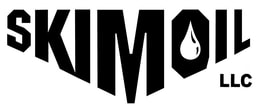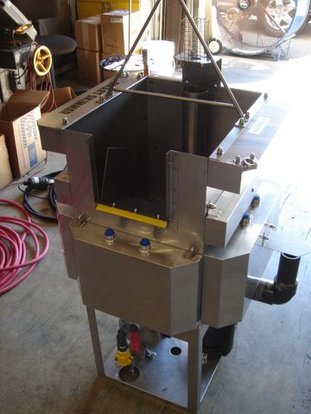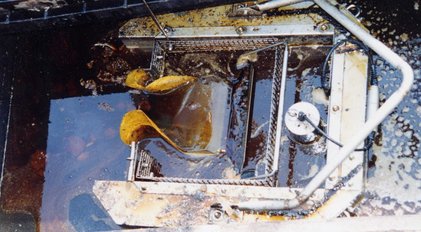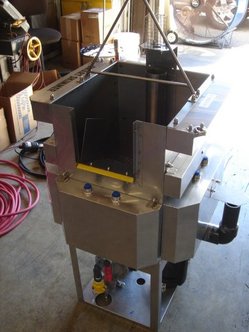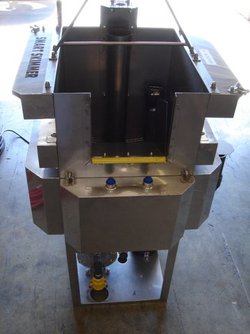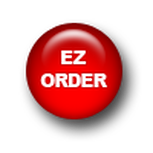Automatic Floating Weir Oil Skimmer-Separator
Automatic self contained smart oil skimmer system
|
|
Automatic smart oil skimmer system is a self contained skimmer purposely built for specific jobs. Originally designed for hydro dams---to go down into very deep wells and automatically skim and separate oil from water and pump the oil up to the surface ---automatically. With onboard pumps, controls, and monitoring, the automatic floating weir oil skimmer is fully programable The model #800AWS will remove 100% of free and floating oils from storm and wastewater. The Auto-weir floating skimmer will automatically detect, engage, accumulate and off load oil. What makes the Auto-weir floating skimmer automatic is a programmable PLC which controls the basic operation, monitors conditions and initiates preventative maintenance. All functions can be customized for site-specific operations including reporting for compliance requirements. This system is also available as the dumb cousin—without the automation—it’s still a great way to skim oil without the hassle and risk of discharging or otherwise dealing with the water. >>>>>>>>>Typical Automatic Skimmer / Auto Skimmer / Smart Skimmer |
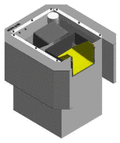
APPLICATIONS:
The Auto-Skimmer removes floating oils from pits, tanks, storm water collection tanks or sumps. Perfect for non-point source floating oil removal such as monitoring wells, bypasses, scale pits, runway runoff, maintenance yards, mining applications, and API separators or any still water surface. Operating conditions can be monitored remotely making this oil skimmer ideal for inaccessible locations.
The Auto-Skimmer removes floating oils from pits, tanks, storm water collection tanks or sumps. Perfect for non-point source floating oil removal such as monitoring wells, bypasses, scale pits, runway runoff, maintenance yards, mining applications, and API separators or any still water surface. Operating conditions can be monitored remotely making this oil skimmer ideal for inaccessible locations.
|
AUTOMATION & OPERATIONAL CYCLE
Skimming Cycle — A typical skimming cycle for a storm water run-off sump will begin with a rise in the tank water level indicating rain. The skimming will continue for a preset period of time in order to cycle the whole surface area and remove any oils, which are coming out of suspension. If the #800AWS detects a sufficient amount of oil has been collected in the skimming cycle, the oil will be off-loaded. The floating oil skimmer will stop when the oil has been removed. Skim Capability -- The system creates a flow of surface water and floating oils (a skim) into the oil skimmer, attracting floating material from the entire surface area. Floating oil is accumulated in the skimmer body and the carrier water is returned to source through vents in the bottom of the skimmer. Skimming is continual as long as oil accumulation is indicated. The gpm of both the skim and the oil off-load is variable. The skim has 360 degrees surface attraction so positioning of the skimmer in the sump is more dependent on access considerations and turbulence patterns. |
Automation -- All functions are controlled with a PLC. Operational parameters are factory set for typical use, but are easily modified for optimization for a specific installation. In addition to customizing operations the PLC will monitor oil skimmer functions, advise of failures; such as need to clear debris or pump failure, and can even report on oil recovery cycles to help with compliance reporting. The Auto- skimmer may be linked to central controls or function independently.
|
Oil Off-Load — The system will assess the accumulation of oil and off-load when there is a sufficient amount of oil collected. An oil off-load cycle will initiate another collection cycle with the assumption that all free-floating oil has not yet been removed. Only when an oil skimming cycle has been completed without the need for an off load will the system go inactive, and wait for the next "start" activation signal.
In most cases a "tank full" over-ride. This is provided to prevent offload when the receiving tank is full. An optional feature will monitor the frequency of oil off load and if the oil recovered exceeds a pre-determined amount the system will signal a possible spill condition. |
|
Pumps and Instrumentation — The system uses two pumps, one for oil skimming and the other for oil off-loading. The pumps are selected to fit into the customer’s environment. The oil skimmer controller reacts to changes in the liquid levels in the skimmer. This information tells the controller if a "skim" is taking place, and when sufficient oil has been accumulated so as to trigger oil-off load. An ultra-sonic level detector detects the liquid levels in the skimmer. This detector never touches either the water or the oil, and therefore will not stick in old oil as float switches do. Information regarding the oil skimming operation is also passed to the PLC so that minor problems can be automatically corrected without the need for intervention.
|
OPERATIONAL CONSIDERATIONS
Capacity -- The capability of the skimmer to clean a given surface will vary based on the type of oil on the surface. As an example, the floating oil skimmer will clean 150 square feet of surface area in about one hour. This area will be collected and all the oil, whether it is a sheet or gathered in small islands, will be processed.
Turbulence -- The signals from the skimmer are "averaged" so as to screen out false signals caused by turbulence and the mass of the skimmer is great enough that is will not be tossed about. However, turbulence (and cross winds) should be minimized as much as possible as turbulence impedes the ability of oil droplets to float to the surface. This may push the floating material to one side of the sump where it will be held away from the skimmer. The floating skimmer is programmed to run two hours after the liquid level has subsided to reduce the effect of turbulence.
Debris -- Debris is frequently a problem in skimming operations and we encourage customers to take steps to reduce the amount of debris that can get into the sumps. The model #800AWS has the following debris protections. There is a screen grid in front of the skimmer that allows the liquid surface to pass easily toward the skimmer, but larger items (bottles, cans, most wood chunks, gloves, etc.) will be kept out. These items will be attracted to the skimmer and if present, must eventually be removed. In the skimmer body is a debris collector basket of approximately two cubic feet of capacity. This is intended to catch debris that gets past the outer screen. Eventually this basket must be emptied, but it is conceivable that it could easily hold a year’s accumulation of cigarette butts. The detection system in the floating skimmer will give an indication when there is debris that is interfering with the oil skimming operation. Finally, the pump intakes are screened and the oil off-load pump has a "y" trap filter.
Maintenance -- With the exception of debris removal, the floating oil skimmer system should be virtually maintenance free. The pumps have been selected because of their capability to run almost indefinitely in this application. It is possible, that some types of oils (example: salad oil) may solidify and interfere with some float switch operations; even though the system is designed to minimize this type of interference and programmed to detect it, it is advisable to clean the components on an annual basis.
Capacity -- The capability of the skimmer to clean a given surface will vary based on the type of oil on the surface. As an example, the floating oil skimmer will clean 150 square feet of surface area in about one hour. This area will be collected and all the oil, whether it is a sheet or gathered in small islands, will be processed.
Turbulence -- The signals from the skimmer are "averaged" so as to screen out false signals caused by turbulence and the mass of the skimmer is great enough that is will not be tossed about. However, turbulence (and cross winds) should be minimized as much as possible as turbulence impedes the ability of oil droplets to float to the surface. This may push the floating material to one side of the sump where it will be held away from the skimmer. The floating skimmer is programmed to run two hours after the liquid level has subsided to reduce the effect of turbulence.
Debris -- Debris is frequently a problem in skimming operations and we encourage customers to take steps to reduce the amount of debris that can get into the sumps. The model #800AWS has the following debris protections. There is a screen grid in front of the skimmer that allows the liquid surface to pass easily toward the skimmer, but larger items (bottles, cans, most wood chunks, gloves, etc.) will be kept out. These items will be attracted to the skimmer and if present, must eventually be removed. In the skimmer body is a debris collector basket of approximately two cubic feet of capacity. This is intended to catch debris that gets past the outer screen. Eventually this basket must be emptied, but it is conceivable that it could easily hold a year’s accumulation of cigarette butts. The detection system in the floating skimmer will give an indication when there is debris that is interfering with the oil skimming operation. Finally, the pump intakes are screened and the oil off-load pump has a "y" trap filter.
Maintenance -- With the exception of debris removal, the floating oil skimmer system should be virtually maintenance free. The pumps have been selected because of their capability to run almost indefinitely in this application. It is possible, that some types of oils (example: salad oil) may solidify and interfere with some float switch operations; even though the system is designed to minimize this type of interference and programmed to detect it, it is advisable to clean the components on an annual basis.
Smart Skimmers
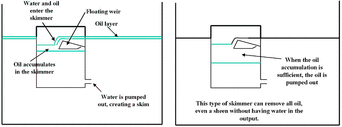
The "Smart Skimmer" series skims both oil and water (and debris in some instances) and accumulates the oil in the skimmer body. When the accumulation of oil is sufficiently deep, it is pumped off. This skimmer can deliver oil with no water even if skimming sheen. It is extremely versatile, and can be adapted to virtually any oily water condition. Moving parts are limited to an oil accumulation switch and to a floating, hinged weir.
The fixed weir and the smart skimmer have been used by industry for more than a decade. Although we are somewhat bias, we feel that these skimmers deserve your inspection. Consider your current oil skimming problems including maintenance, and compare this to the Skimoil Inc. oil only weir skimmers and/or our other selective skimming technologies. We Love Oil!
The fixed weir and the smart skimmer have been used by industry for more than a decade. Although we are somewhat bias, we feel that these skimmers deserve your inspection. Consider your current oil skimming problems including maintenance, and compare this to the Skimoil Inc. oil only weir skimmers and/or our other selective skimming technologies. We Love Oil!
|
Skimmer Specifications:
Construction: Stainless Steel Dimensions 24" x 24" x 24" Weight: 65 lbs (dry) Skimmer head has internal float sensors, debris basket, and jet nozzle. |
Pump Specifications:
Water pump: Gould Pump NPE 316L Construction: stainless steel Capacities to: 75 gpm Head to: 39 feet Working pressures to: 125 psi Maximum temperatures to 212 f Motor: TEFC, 60 Hz; 1/2 hp; single phase, 110v |
Oil Pump:
Continental Pump CP-44 Construction: case iron Capacities to: 15 gpm Suction head: 22 feet Working pressures: 25 psi Maximum temperature: 190 f Motor: TEFC, 60 Hz; 1/2 hp; single phase, 110v |
Control Box: Logic: embedded 386 computer; Nema 4;
Power Supply: One 110 volt, 20 amp circuit for the pumps One 110 volt; 5 amp circuit for the control box
Power Supply: One 110 volt, 20 amp circuit for the pumps One 110 volt; 5 amp circuit for the control box
